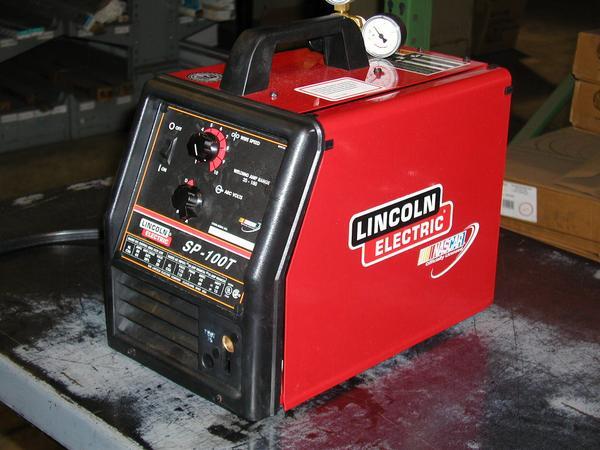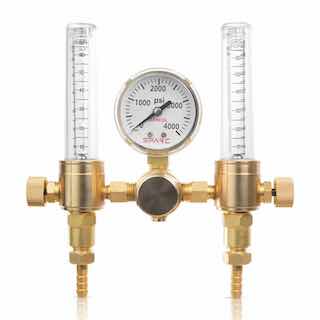Lincoln Mig Welder
"are those little red Lincoln MIG welders at home depot worth a crap?!.. "
the lincoln mig welders you see at home depot and other big box stores are not built the same as the ones you see at the lincoln electric web site.
There are 2 versions...The one you see on lincolnelectric.com is built better...the one in Big box stores is imported and some components like wire feeding mechanism are lower quality.

"I see these all the time on craigslist!.. "
Shopping for a Lincoln Mig Welder ?
Bare wire MIG vs. Flux-Core: Which is Best?
The answer is YES. That’s because its apples and oranges really. If you’re buying your first Lincoln MIG welder, you want both options. That means ponying up the extra few bucks for the capability of using shielding gas and bare wire.
Why?
Because that’s how you weld really thin stuff like fenders and body panels. You will need to get E70s6 spool wire in .023” to .025" diameter along with a bottle of 75/25 argon/co2 gas.
Use the flux core wire for welding outside and on your brother in laws rusty gate.
Definitions
Gas Metal-Arc Welding:
(GMAW) as identified by the American Welding Society, is mostly known as MIG (Metal Inert Gas) and uses a continuous solid wire electrode for filler metal and an externally supplied gas (typically from a high-pressure cylinder) for shielding. The wire is usually mild steel, typically copper colored because it is coated with a thin layer of copper to protect it from rusting. The machine must be setup for DC positive polarity. The shielding gas, which is usually carbon dioxide or mixtures of carbon dioxide and argon, protects the molten metal from the atmosphere. Shielding gas flows through the gun and cable assembly and out the gun nozzle with the welding wire to shield and protect the molten weld pool. Molten metal is very reactive to oxygen, nitrogen and hydrogen from the atmosphere, if exposed to it. Even a slight breeze can blow the shielding away and cause porosity. That's why welding outdoors is usually avoided unless special windscreens are used.
But if you are indoors and welding fairly clean metal, a Lincoln MIG welder with bare wire and shielding gas makes awesome looking welds. Some basic process fundamental knowledge and good technique allows welding up to around 3/16” metal. And for thin sheet metal, it’s the only way to go. The metal will warp less and there will be less grinding. Another plus is you won’t blow as many holes as you will with flux core.
Aluminum MIG
Welding aluminum requires much more than just changing to aluminum wire. Get comfortable welding steel first. Since aluminum is very soft, it requires aluminum drive rolls that have a U-groove and no teeth to bite or cause wire flaking. Cleanliness of the wire and base metal are critical. Wipe the material with acetone on a clean shop rag. Use stainless steel wire brushes that have only been used on aluminum. Drive roll tension and gun length must be minimized. A Teflon, nylon or similar gun liner is needed to minimize friction in feeding the wire and 100% pure Argon gas is required for shielding. Special contact tips are often recommended. Special gun movement techniques are often highly desirable. It is a challenge, but it can be done.
Self-shielded Flux-Cored Arc-Welding process
(FCAW per the American Welding Society), or flux-cored for short, is different in that it uses a wire which contains materials in its core that, when burned by the heat of the arc, produce shielding gases and fluxing agents to help produce a sound weld, without need for the external shielding gas. It’s a lot like Stick welding except for its easier. Most flux core is even good enough to weld in a strong breeze. The flux helps the arc to penetrate more than bare wire MIG, but it has spatter. When finished, the weld is covered with a slag that usually needs to be removed. A "drag" angle for the gun is specified which improves operator visibility. The settings on the wire feeder / power source are slightly more critical for this process. Improper technique will have results that are magnified. This type of welding is primarily performed on mild steel applications outdoors. The Innershield .035" NR-211MP is a good choice for the 115 volt machines and the .045" Innershield NR-211MP is good choice for 230 volt machines.
Hot Tip...Hobart Fabshield 21b is the Shiznit! and runs with no gas..thats right I said no gas!
General Usage Rules for Lincoln Mig Welders
MIG welding with your Lincoln mig welder
As a rule of thumb, it is recommended to use a compact 115volt input MIG wire feeder/welder indoors on clean new steel that is 24 to 12 gauge thick. 12 gauge is a little less than 1/8" thick. 24 gauge is less than 1/16" thick. (You can weld a little thicker if you can preheat and weld uphill.)The smallest wire(.023") is the bomb for bodywork.
If you need to weld ¼" or thicker material with MIG, you will need the higher capacity machine which will require 230 volt input. The 230 volt machine could also run .035" diameter wire. To MIG weld material more than ¼" thick, you need a higher capacity truly industrial machine. If most of your welding will be performed indoors on clean material that is less than 1/8" thick, a MIG machine that operates on 115 volts is probably your best bet for economic reasons in that a 230 volt input machine will be more expensive.
Flux-Cored
The flux-cored process is only recommended on materials as thicker than 20 gauge, a bit thicker. In general, this process is best for welding thicker materials with a single pass, especially if you need to weld outdoors such as to repair a tractor out in the field. A 115 volt flux-cored machine using an electrode such as .035" Innershield NR-211-MP will generally allow you to weld steel up to ¼"thick. With the proper electrode on a proper machine, such as .045" Innershield NR-211MP, and a 230 volt input machine, you can weld steel up to 1/2" thick. Note that NR-211MP requires that the machine be setup for DC negative polarity.
Advantages/Disadvantages using a Lincoln mig welder
While there are advantages and disadvantages to both processes, we will try to outline for you some of the most common.
MIG
Advantages
The best choice when cosmetic appearance is an issue since it provides lower spatter levels than flux-cored. The arc is soft and less likely to burn through thin material.
The lower spatter associated with MIG also means no slag to chip off and faster cleaning time.
MIG is the easiest type of welding to learn and is more forgiving if the operator is somewhat erratic in holding arc length or providing a steady travel speed. Procedure settings are more forgiving.
If you are skilled and get specific proper guns, shielding gas, liners, drive rolls, and electrode, MIG can weld a wider range of material including thinner materials and different materials such as stainless, nickel alloys or aluminum.
Disadvantages
Since a bottle of external shielding gas is required, MIG may not be the process of choice if your are looking for something that offers portability and convenience. MIG also requires additional equipment such as a hose, regulator, solenoid(electric valve) in the wire feeder and flowmeter.
The first thing is to prepare the surface by removing paint, rust and any surface contamination.
MIG has a soft arc which will not properly weld thicker materials (10 gauge would be the maximum thickness that MIG could soundly weld with the 115 volt compact wire feed welders we are referring to or ¼" with the 230 volt input compact wire feed machine.) As the thickness of the material(steel) increases, the risk of cold lapping also increases because the heat input needed for good fusion is just not possible with these small machines. Flux-Cored
Advantages
The Self-Shielded electrodes are best for outdoor welding since the flux is built into the wire for positive shielding even in windy conditions. An external shielding gas and additional equipment are not needed, so setting up is simpler, faster and easier.
The flux-cored process is most suited for applications with thicker materials as it is less prone to cold lapping.
Disadvantages
It is not recommended for very thin materials (less than 20 gauge).
When flux-cored welding, machine settings need to be precise. A slight change in a knob position can make a big difference in the arc. In addition, the gun position is more critical in that it must be held consistently, and at the proper angle, to create a good weld.
This process creates spatter and slag that may need to be cleaned for painting or finishing. It should be noted that the same machine can be used to weld with both MIG and flux-cored processes though a special package is usually needed to change from one application to the other. Drive rolls, shielding gas, gun liners and contact tips and procedure settings need to be addressed when changing processes.
Choosing Wire
Another area that may cause the novice welder some concern is how to choose the best wire. Proper electrode diameter is related to plate thickness and the welder you have. A smaller wire makes it easier to weld thinner plate.
For a 110 volt input MIG machine, 025" is the smallest available size and the easiest to use on very thin material.
Realize that these small machines are good, but they cannot do everything.
Top Ten things to Help you not SUCK at Mig Welding
1) It is very important to get a good, solid ground connection. This means you should thoroughly clean or grind the surface of the metal where attaching the ground clamp and use a tightly attached work clamp so electricity can easily flow through the work piece and back to the welder. Paint and rust are insulators. Remove them. This is a very common mistake to overlook. If you have ever heard the machine gun burst when someone pulls the trigger on a mig gun, you have heard the sound of a bad ground connection. It doesn't matter whether you are using a Miller, Century, or Lincoln mig welder. A bad ground connection will make things go south quickly. To learn how to make an awesome ground booster click here Awesome Ground booster
2)Plug the mig welder on a separate circuit breaker that is properly fused as stated in your Operators Manual. Don’t buy an extension cord at the dollar store and expect things to go well. You are melting steel here. You cannot weld with inadequate input power. Don't even try. The torch on a Lincoln Mig welder is not a magic wand.
3) Good fit up is a big plus. Avoid gaps whenever possible to minimize burn through problems. This is especially critical on thin sheet metal. Again the lincoln mig welder torch is not a magic wand that will heal bad fitups.
4) Keep the gun cable as straight as possible for smooth wire feeding. Don't sharply bend it. Don’t even let it loop at all if possible, arrange the torch cable so that the wire can feed easily.
5) Make sure the contact tip hole looks good (not elongated or melted) and it is tightened to the diffuser. You can run a tip cleaner through it and dress the tip with a file or grinder to extend the life of the tip buy don’t be a cheap ass. Keep a pack of welding tips in your toolbox at all times. All the fun can easily be squished out of welding by trying to pinch pennies by welding with a crapped up tip.
6) Cut the wire at an angle to a point before starting to weld for better starts.
7) Use correct electrode stickout and maintain it as well as proper welding procedures. Correct stickout means about ½ inch. For short circuit bare wire mig. A longer stickout on thin sheet metal can help. On thicker metal it softens the arc and makes the weld pile up without penetration. Not good!!
8) Make sure the drive rolls feed smoothly with proper tension.
9) Relax and try to hold the gun as steady and smooth as possible. Take a few dry runs before you flip the helmet down. Things look different in the dark.
10) Make sure you observe and follow all welding safety precautions. For more details, consult ANSI Z 49.1.
11) Oops! there were only supposed to be 10 things about welding with a lincoln mig welder! So here is a bonus...USE BOTH HANDS!!! holding the torch with one hand is a sure way to make a weld that looks like Fido's ASS
good luck Leave Lincoln Mig Welder and view home page














